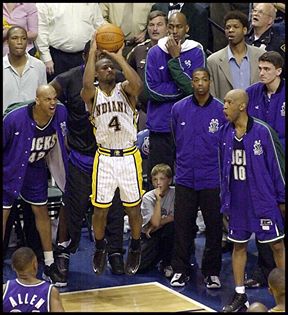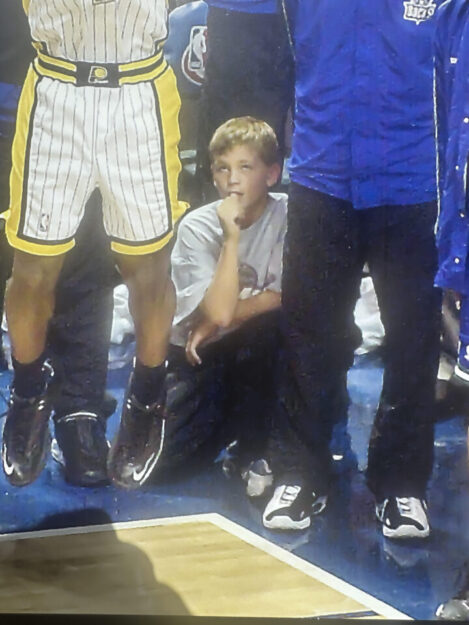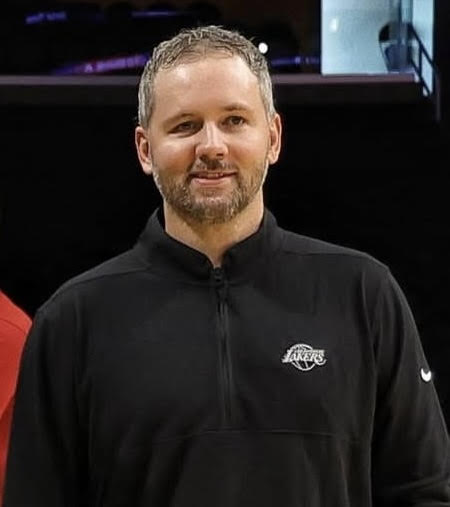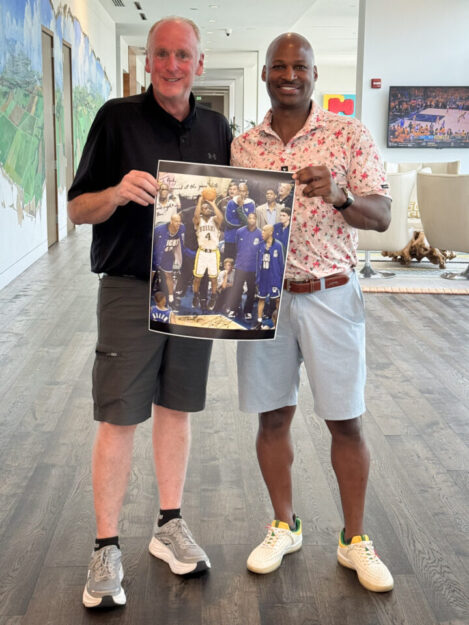
I covered the Pacers for The Indianapolis Star from 1996 to 2008. Their playoff run to the NBA Finals in 2000 was a highlight of that period, of course. Game 5 of their first-round series with Milwaukee was the highlight of that season. And Travis Best's three-pointer from the left corner was the highlight of that game.
It's a moment that involves many supporting characters, from Best's deceased ancestors to the Milwaukee ballboy crouched in the corner to the photographer who caught it with a timely snap of the shutter.
Let’s start with the photograph, Randy Baughn’s timely snap of the shutter that captures the biggest shot in the history of the Pacers’ franchise. Take a close look.
Travis Best is cornered, surrounded by men in purple. They are prevented from doing physical harm by clearly defined boundaries, but they are threatening. Scott Williams is standing behind him, shouting something. An open-mouthed Sam Cassell is off to his left, apparently doing the same. Danny Manning, Rafer Alston and Mirsad Turckan are standing nearby in passive poses but are practically close enough to touch him. So is a 12-year-old kid - a future coach - crouched in the corner, calmly looking up at Best with his chin resting on his hand. J.R. Reid, in street clothes, stands on the periphery.
Meanwhile Ray Allen, in the lower left, is moving toward Best to contest the shot but too far away to do anything about what is about to happen.
What happened was a three-point shot with 16.5 seconds left in the decisive game of the Pacers’ first-round playoff series with Milwaukee on Thursday, May 4, 2000. It gave the Pacers a two-point lead they clung to for dear life as the seconds slowly trickled off the scoreboard at Conseco Fieldhouse and allowed them to escape with a 96-95 victory that not only captured their best-of-five series but propelled them all the way to the franchise’s only NBA Finals appearance.
All these years later, Best considers that shot the highlight of his basketball life.
“Definitely, because of the implications,” he said.
*
So many implications. And so many subplots.
Without that shot, which erased a horrible shooting game for Best, the Pacers likely lose to the Bucks and live forever with the ignominy of a No. 1 seed losing to an eight-seed. If that happens, general manager Donnie Walsh is forever second-guessed for not breaking up his aging team following the previous season’s loss to New York in the conference finals. And Larry Bird’s coaching career is viewed in a much harsher light. And one of Reggie Miller’s greatest postseason performances is smothered by the wet blanket of a crushing defeat.
It’s easy to forget now, but Miller scored a playoff career-high 41 points in the game, 18 of them in a 7 ½-minute flurry in the fourth quarter. But he also made a key play that set up Best’s kill shot, a fundamental decision that would have eluded many players – particularly star players - in the heat of the moment that speaks just as highly of Miller’s ability to perform in the clutch as all those historic three-pointers.
“My recollection of that game is Reggie scoring that 41 and getting us out of that game,” Best says today. “I was happy doing my little part.”
Best’s part was more than little. It was the explosive climax of preparation, persistence and patience that will resonate for the life of the franchise. There’s a reason it’s shown on the overhead video board every time Best flies in from his home in Springfield, Mass. to catch a home game.
Today, it seems almost as if the Pacers were fated to win, that the basketball gods had rewarded them with a massive makeup call for past disappointments, although Best believes he had personal angels in his corner. The Pacers trailed by as many as 10 points in the game, by six in the fourth quarter and by three in the final three minutes. Miller kept bringing them back, closer and closer, until finally hitting what seemed like the gamebreaker with a three-pointer that provided a 93-92 lead with 1:37 remaining.
He had 41 points at that point, his playoff career high and a playoff high for any Pacer in the franchise’s NBA history. But the Pacers couldn’t build on it. Their defense forced a miss after Miller’s shot, but he dribbled the ball off his foot driving along the right baseline on the Pacers’ next possession and Tim Thomas came back with an 18-footer with 48 seconds left to return Milwaukee to a 94-93 lead.
From there, the Pacers needed some luck. Some poise, too. On their next possession, Best drove to his right past Bucks backup guard Vinny Del Negro – a fellow Springfield, Mass. native – and missed a short shot in the lane. Dale Davis, unable to control the ball cleanly, missed a lefthanded put-back, but the deflected rebound bounced off Bucks forward Glenn Robinson and out of bounds with 29.4 seconds remaining.
A break.
After a timeout, the Pacers took the ball out underneath their own basket. They wanted to take a quick shot to create a two-for-one opportunity so they would have time for another possession if Milwaukee scored. Rose inbounded to Best, who ran off a Davis screen and quickly fired a shot from just inside the three-point line on the left wing. It hit the back of the rim and bounded fortuitously to the right, where Davis managed to corral it 15 feet from of the basket.
Davis flipped the ball to Miller in the right corner, but with Bucks center Ervin Johnson squaring up on him Miller gave a quick shot fake and dribbled hard to his right, brushing past Johnson and tightrope-dribbling along the baseline. It’s not clear on the broadcast, but his right foot might have grazed the end line. He passed to Best in the left corner and Best immediately fired a pass out front to Rose, a step outside the three-point line.
“The crowd is silent,” TNT announcer Marv Albert said on the broadcast.
Not for long.
With tension mounting, Miller raced to the left wing to get open for a three-point shot. Rose then took three hard left-handed dribbles toward the basket, drew a double team from the scrambled Bucks defense and passed to a wide-open Best in the left corner. Ignoring the shouts of all those Milwaukee players surrounding him, not to mention the memory of all of his missed shots that evening, he swished it.
“You talk about believing in yourself! This young man was 2-for-14 from the floor!” TNT commentator Mike Fratello said as the Bucks called timeout to prepare for the final 16.5 seconds.
The crowd was no longer silent. But amid the bedlam Best walked slowly toward the Pacers’ bench, head down, a blank expression on his face with arms raised. He was relieved, not joyful, and sending a private message. Starting point guard Mark Jackson met him as he approached the bench and embraced him in a hug. Larry Bird gave him a quick pat on the behind while walking out to talk with the assistant coaches. But too much time remained to celebrate or assume.
Cassell had fouled out of the game, so Allen took over at point guard on Milwaukee’s possession. He exchanged Best for Rose as a defender after dribbling off a screen, then beat Rose on the right baseline. Davis came over to force a miss but was called for a questionable foul when he and Johnson fought for the rebound with 6.2 seconds left.
Johnson missed the first attempt. Fratello said on the broadcast Bucks coach George Karl had told Johnson to miss the second purposely to create a rebound opportunity. But Johnson hit that one. The Pacers now had a one-point lead and the ball.
Milwaukee didn’t manage to commit a foul until Rose was grabbed with just 1.4 seconds left. Rose was 4-of-4 from the line in the game and an 83 percent shooter during the regular season but missed both. Allen grabbed the rebound and called timeout with 1.1 seconds left. That left time only for Allen to take Del Negro’s inbound pass on the left sideline near midcourt, dribble once to his left and fling an off-balance shot from about 35 feet that didn’t come close.
*
Even then, with victory in hand, relief reigned for the Pacers. There was no on-court celebration among the players, just hugs and handshakes with the underdog team that had nearly derailed their season. Miller, waiting to go on the air with his sister Cheryl for an on-court interview, buried his head in her shoulder for a moment to collect his thoughts.
“You’ve got to give Milwaukee all the credit in the world,” he said. “We might have won the series, but they were the better team. We’re fortunate to be moving on.
“Experience won out tonight.”
Experience, homecourt advantage, some fortunate bounces and faith – especially from Bird and Best. Bird said afterward he never considered pulling Best from the game despite his errant shooting performance because he was playing great defense on Allen, who finished 6-of-21 from the field.
“I was going to leave him in there all the way,” Bird said afterward. “I knew he would get his shot sooner or later.”
Best did, too.
“I felt like all the shots were good,” he says now. “I didn’t feel any lack of confidence. I felt like I needed to play free and play my game and live with the results. That’s not a game you can hold back on. You can’t be afraid of losing. I was proud of the way I played. I wasn’t proud of the way I shot the ball, but I was confident and that’s what allowed me to hit that shot. All the post-practice work we would do behind the 3-point line, that allowed me to have confidence.
“When the ball was swinging to me, I knew all the implications. But all the practice I put in allowed for a natural rhythm to release that shot.”
Miller had taken notice of that from his position on the wing. After the game, on his way to the postgame press conference, he stopped by Best’s locker, gave him three quick hand slaps and laughed.
“You were like at shooting school!” he crowed, then acted out a relaxed shooter taking a deep breath, bending his knees and following through on a shot.
Best’s shot is the most impactful in franchise history because none of the ABA championships, in 1970, ’72 and ’73, hinged so precariously on a single field goal. Byron Scott’s game-winning three-pointer in the opener of the first-round playoff series with Orlando in 1993 was huge, lighting a fire that burned all the way to the conference finals, but it was a winning shot in Game 1. The Pacers would have had other opportunities to win that series if he had missed. Miller’s eight points in 8.9 seconds will stand forever as an iconic moment, but that was a sequence rather than a shot, and that season ended in the conference finals.
Best’s shot was a fitting conclusion to a time-tested, fire-hardened team mentality that had been honed by heartbreaking losses in the conference finals the two previous seasons. The possession that led to his three-pointer, including the weakside rebound, ball reversal, ball movement and decision-making was a classic piece of offensive execution in the most challenging of circumstances.
“It took everything we’ve ever learned to find some kind of way to beat them,” Miller said after the game.
All these years later, Best agrees.
“That pass (from Rose) says a lot about our team,” he says. “Reggie was right there on the wing, the person we always wanted to have the ball in his hands. The fact we knew each other so well and had that confidence in one another, that Jalen would give me the ball … everybody on that team had earned that respect from one another from the trials and tribulations we had gone through together. It says a lot about the entire team. Which is why we were able to go so far.”
Best’s shot gave him what every athlete dreams about - a picture-perfect highlight that will outlive his career and even his life.
“You scrap and fight so hard, you want to leave one for the annals,” he says.
*
The passing years have only added layers to the story.
Remember Best’s silent head-bowed, arms-raised reaction? He was saying thanks to two relatives who had recently passed away.
“Nobody knows this, but when I raised my hands, I was thinking about my mother’s mother and my father’s brother, who played (basketball) with my father in high school,” Best revealed in 2025 while in Indianapolis for the NBA Finals. “I was thinking, thank you. Thank you for guiding the ball into the rim.”
Remember the kid crouching in the corner of the court, just a few feet away from Best? He was assumed to be affiliated with the Pacers somehow, as it’s common practice for the home team to supply ballboys for visiting teams. It turns out he was a well-connected 12-year-old Milwaukee kid named Dane Johnson, whose father, Price, was a longtime friend of Milwaukee coach George Karl and a fringe member of Karl’s staff – a “special assignments” coach.
Dane traveled with the Bucks on their private jet throughout the playoffs for a few years. He accompanied Karl in and out of the arena on every road trip, usually carrying the suit Karl wore during games. He had countless other brushes with fame, too. His family lived near Allen in Milwaukee and sometimes went to his house to play video games. He also helped Allen with his pregame shooting routine with rebounds and passes. He had even been introduced to Miller and Bird during the regular season.
Dane’s family later moved to Columbus, Ohio, where he attended high school. He then played two seasons at Portland State, averaging 2.3 points over two seasons, and then entered the coaching fray. He was an assistant for the Lakers for eight years, including a season as head coach of their G League team, and spent 2024-25 as the associate head coach of Sacramento’s G League team. He worked with the Kings’ summer league team in 2025.
All these years later, he doesn’t have many memories of the fateful Game 5 in 2000.
“My remembrance of the shot is a little foggy, but I remember the game,” he says. “I remember how loud it was. It seemed every shot was so loud for them and every shot for us was boo-boo-boo.”
He doesn’t recall much from the postgame locker room, either.
“I just remember being down after the game,” he says. “When I was around George in particular.
“If I remember correctly, George was good in the locker room with the team, then after that (with the coaches) he was really disappointed.”


And don’t forget Baughn. He factors into the story as well. He was a photographer for The Indianapolis Star at the time but worked mostly in advertising. He wanted more opportunities to shoot for the news side and was thrilled to have a credential to shoot the home playoff games that season.
He arrived late for Game 5 after working a full day in other capacities, so a spot wasn’t available for him to sit on the floor with the other photographers. The best he could do was find a place on the porch halfway up the fieldhouse opposite the team benches, where television cameras were positioned.
That put him in the perfect place to capture Best’s historic moment, far better than any of the floor-bound photographers had. It stands as a career highlight for him as well, a great shot of a great shot.

Game highlights can be seen here.
A video and breakdown of the play that led to Best's shot can be seen in the Audio/Video section.
Tagged with: 2000 NBA playoffs, Dane Johnson, Jalen Rose, Reggie Miller, Travis Best
 Pacers
Pacers